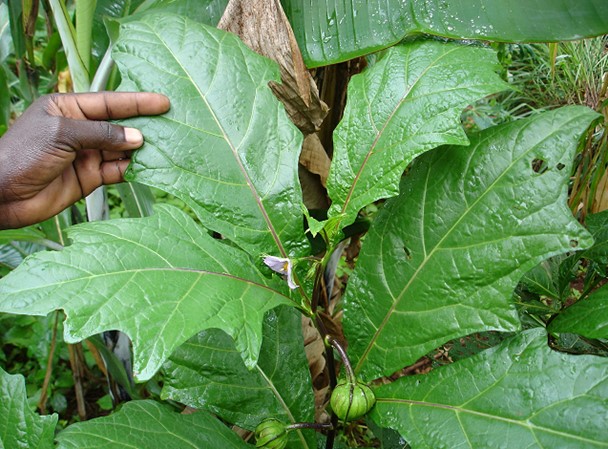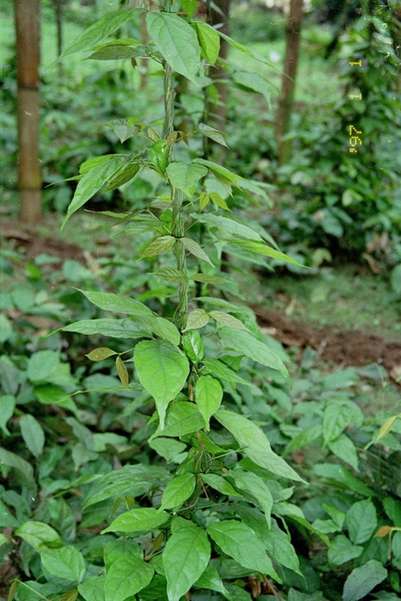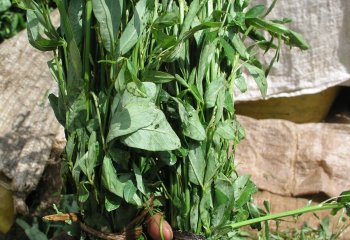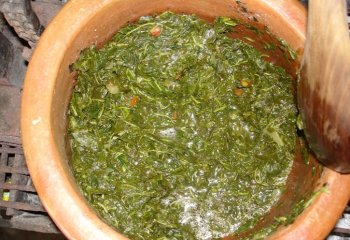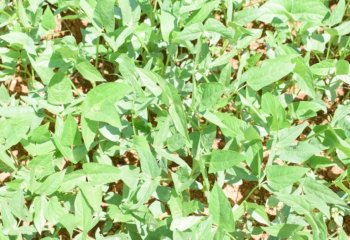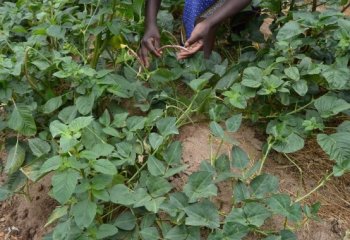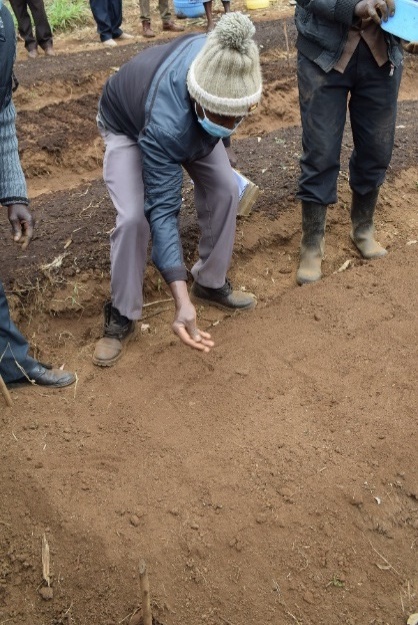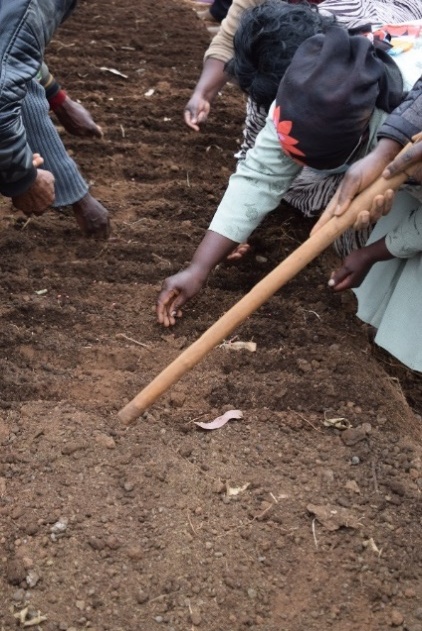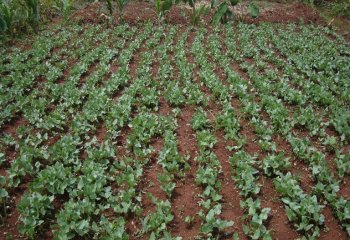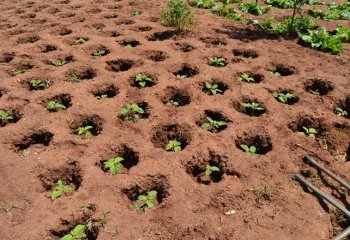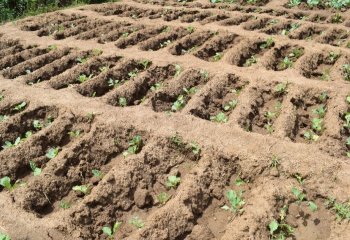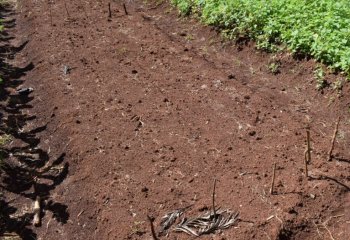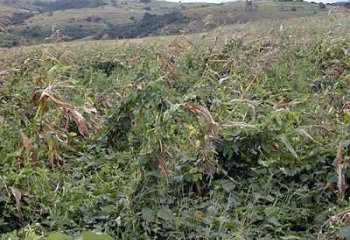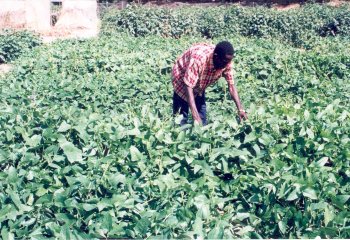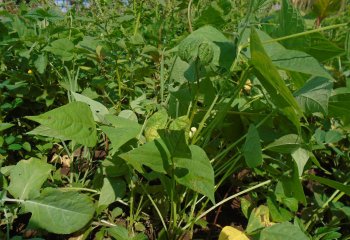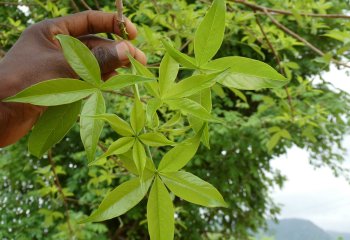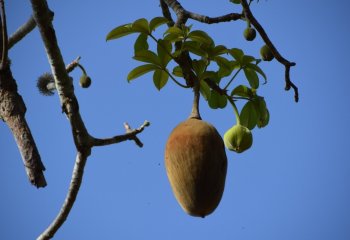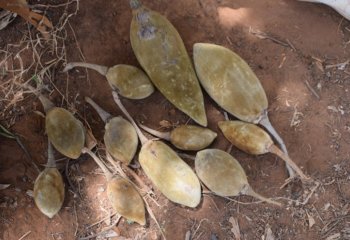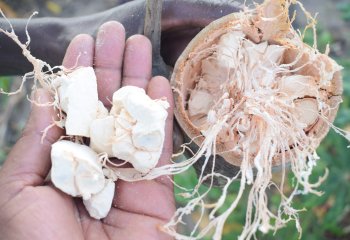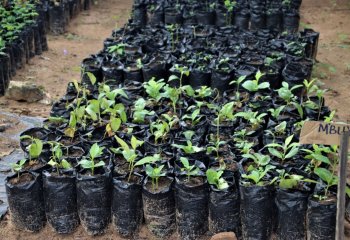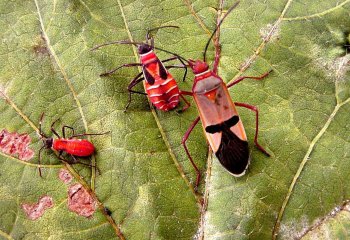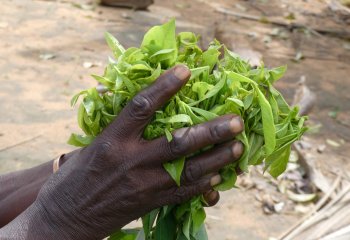Blackjack (New)
Main Content Block
Introduction
Blackjack belongs to the sunflower family, Asteraceae in the genus, Bidens which comprises around 200 species of annual or perennial herbs. Blackjack (black jack) in the African region may refer to any of the four or more species of related plants that are used as vegetable in various parts of the continent and especially Southern Africa: Bidens pilosa, Bidens bipinnata, Bidens biternata and Bidens schimperi. Young plants of blackjack may be confused with Galinsoga parviflora (Gallant soldier (English) but the leaves are a good distinguishing feature. The leaves of Galinsoga parviflora have a short stalk, and not divided into 3 leaflets. It is native of South America, but naturalized in tropical, subtropical and temperate parts of the world. It is also occasionally used as a leaf vegetable.
General information (Species account and ecological information)
@ P Maundu, 2006
In B. pilosa, the leaves are divided into 3 leaflets and the conspicuous peripheral petals are white. Bidens bipinnata (yellow-flowered blackjack) is similar to Bidens pilosa except that the former has yellow petals and more narrow leaflets that are divided (lobed). B. bipinnata is a cosmopolitan weed originating in Europe and Asia. B. biternata can be distinguished by the leaves, which are usually divided into 5-7 leaflets. The flowers are yellow. B. biternata is less frequently encountered and is believed to of African origin. B. schimperi has ribbed stems that are often purplish. The leaves are deeply divided into leaflets that are further divided into deep thin lobes and these may be lobed again. The peripheral flower petals are yellow. It is considered native with a distribution from Ethiopia to South Africa.
Bidens pilosa, is the more common of the four. This species is a highly adaptable and widespread, being found especially in tropical and warm temperate regions worldwide. In Africa, it is particularly prevalent and has a cosmopolitan distribution. The plant is known to thrive in various habitats, including disturbed areas, agricultural fields, grasslands, and along roadsides. In Africa, it is considered a widespread weed and an invasive species in many countries. Its reputation as a weed stem from its ability to outcompete native vegetation and reduce biodiversity in affected areas. Moreover, Bidens pilosa serves as a reservoir for plant viruses that can infect crops, posing a threat to agricultural productivity.
Despite being categorized as a weed, blackjack has been regarded as an edible plant by the Food and Agriculture Organization of the United Nations since 1975, and has been traditionally used as a food and medicine in America, Africa, and Asia. In Africa, the plant's fresh or dried tender shoots and young leaves are collected from the wild and utilized as a leaf vegetable, particularly during times of food scarcity. It is commonly consumed as a potherb, with its culinary use reported in countries such as Sierra Leone, Liberia, Côte d'Ivoire, Benin, Nigeria, Cameroon, DR Congo, Kenya, Uganda, Tanzania, Malawi, Botswana, Zambia, Zimbabwe, and Mozambique. The plant exhibits culinary diversity in its preparation and consumption and provide valuable nutrients such as vitamins A and C, iron, and calcium.
In addition to its role as a food source, Bidens pilosa holds a prominent position in African traditional medicine. For centuries, various communities and tribes have utilized different parts of the plant, such as roots, leaves, and seeds, to treat a wide range of ailments. Its medicinal properties are reported to include antibacterial, anti-inflammatory, antimicrobial, antimalarial, diuretic, hepato-protective, and hypotensive activities. Across Africa, different regions have their own traditional uses for Bidens pilosa. Examples include using crushed leaf sap to promote blood clotting, employing leaf decoctions to alleviate headaches, utilizing leaf powder decoctions to address kidney problems, and preparing herbal teas from the plant to reduce flatulence. The plant's extracts are even used to combat malaria in certain areas of southern Africa (Mvere, 2004, Kuo et al, 2021, Sarker et al, 2018, CABI, Xuan & Khanh, 2016).
Species accounts
Bidens pilosa - is a perennial plant that grows up to 0.5 m high and can reach up to 1.5 m in favorable environments. Stem: slender, stiff, and four-angled stems with spreading branches. Stout roots are similar to bulbous roots and spread by underground rhizomes. Leaves: arranged oppositely and feature petioles that extend noticeably beyond the leaf margin. Flowers: Flower-heads are 7-8 mm across with yellow central (tubular) florets. Some plants have flower-heads with white or cream 'petals. Fruits: capsules are about 5 mm long and flat-topped into a beaked shape with three to four valves. Seeds: Black, slender (1-1.5 cm long), ribbed, dry, one-seeded, 2–4 yellowish barbed bristles or awns at terminal end.
Black jack has a high reproductive potential, with a single plant producing up to 6000 seeds per year. Seeds are also widely dispersed through the fruits hook-like bristles that embed themselves in clothing and the fur of mammals and feathers of birds. They are also spread by wind, water and soil and may remain viable for 5-6 years. The plant thrives in diverse habitats and soil types, benefiting from disturbances like fire and tillage. It forms dense stands that outcompete crops and native vegetation. Its allelopathic properties inhibit the growth of native plant seedlings. Additionally, it poses nuisances for transportation and recreation areas. Bidens pilosa is listed as a troublesome agricultural weed impacting at least 31 crops in over 40 countries. It is considered one of the most noxious annual weeds in East Africa. (Mvere, 2004, CABI, Bartolome et al., 2013).
Related species
a. Bidens bipinnata L. commonly known as Spanish needle is a widely distributed weedy species in North and South America, Europe and Asia. It is introduced in Africa and known from Cape Verde, Guinea, Sierra Leone, Côte d’Ivoire, Ghana, Togo, Nigeria, Cameroon, Malawi, Zimbabwe, Madagascar and South Africa. Bidens bipinnata can be distinguished from its close relatives, Bidens pilosa and Bidens biternata by its bipinnatisect leaves. The young leaves of Bidens bipinnata are sometimes consumed as a vegetable. In southern Africa, the young shoots are known for their spicy or tangy flavor and are consumed fresh or dried for storage. It is common for Bidens bipinnata to be mistaken for the more widespread black jack (Bidens pilosa) and is used as a substitute, often in mixtures. In Sierra Leone the leaves are squeezed over boils and are also eaten to cure them. Bidens bipinnata is widely used in South-East Asia as an emmenagogue, expectorant, stimulant, antidiarrhetic and antispasmodic. It is also used in the treatment of conjunctivitis, asthma, insect stings, wounds, earache and snakebites (Bosch, C.H., 2004).
b. Bidens biternata, commonly known as the yellow flowered blackjack is a very widespread plant, growing wild in the temperate regions of eastern China, through to the subtropical and tropical regions of Africa, Asia and the Pacific. It is adventive in temperate regions of western Europe. It can be found in diverse habitats, including wetlands, marshes, fields, gardens, roadsides, thickets, teak forest and along the edges of lakes and rivers. This erect annual herb grows to a height of 1 meter. A distinguishing characteristic lies in its leaves, which commonly exhibit 5-7 foliolate patterns, with the basal pair occasionally exhibiting further divisions. The flowers of this herb manifest a vibrant yellow coloration and incorporate ray-florets. In the case of B. pilosa, the leaves are 3-foliolate, and if there are ray-florets, they will be white. The young leaves of the plant can be harvested and used as a leafy green vegetable. They are often cooked or added to salads, bringing a slightly bitter flavor to culinary preparations. The plant is also extensively used in traditional medicine against inflammation, infections, diabetes, malaria, leprosy, ulcers and diarrhea and digestive disorders (Tropical Plants Database, Zahara et al, 2015, Hyde et al, 2023).
© Maundu, 2005
Ecological information
Black jack grows freely in disturbed places, or as a weed in crops such as cereals, pulses and cotton, in sunny or slightly shaded places, from sea level up to 2400 m altitude. The optimum temperature for germination is 25–30°C. Temperatures below 15°C and above 45°C are not favorable. It thrives in soils with a pH ranging from 4–9 and can tolerate a very high salinity, up to 100 mM NaCl. Flooding reduces seed emergence (Mvere, 2004).
Agronomic aspects
Bidens pilosa can be propagated from seeds, cuttings or divisions making it relatively easy to multiply. The seeds of this plant exhibit non-dormancy and typically sprout within a short span of 3 to 4 days when placed in moist topsoil. The harvested fruits tend to cluster together, forming large, intertwined balls, which can pose a challenge for separation. However, after undergoing a drying and storage process lasting over three weeks, the barbed hooks on the fruits become more fragile and break off easily. The dry seeds themselves are resilient and can remain viable for at least three years. The emergence is good when seed is buried not more than 4 cm in the soil. The seed will not germinate if buried at more than 6 cm. Soaking of the seed in water increases germination. (Mvere, 2004).
Planting
Black jack is a partially cultivated plant found in areas where selective weeding practices are implemented. Its cultivation is straightforward, involving broadcasting or row sowing of seeds, followed by thinning out the seedlings to a spacing of 10-15 cm. When grown for consumption as a vegetable, the plants reach harvest maturity within 4-6 weeks after emergence, prior to seed formation. Multiple plantings, typically 4 or 5 per year, may be carried out. If black jack is cultivated for its leaves, which are used as an antimalarial medicine, removing the flowers becomes necessary to delay senescence and promote continual growth (Mvere, 2004). Care must be taken while growing blackjack since it is a potential weed. Plants could be harvested early before seed formation.
Harvest and post-harvest practices
Harvesting
In cultivation, the initial harvest of B. pilosa typically takes place around 4-6 weeks after sowing, when the plants have reached a height of 15-30 cm. Harvesting methods include manual picking, cutting, or uprooting of the plants. If the plants are pruned or topped, a second harvest can be obtained approximately 2 weeks later. (Mvere, 2004).
Post-harvest practices
Tender leaves, shoots or whole young plants are washed and tied into bundles, after which they may be taken to the market. Although they are not as perishable as most leafy vegetables, the leaves intended for marketing are harvested late during the day or early in the morning so that they remain fresh for marketing. Leaves may also be parboiled and then dried in the sun for later use. Leaves, stems, roots and seed intended for medicinal purposes do not require any delicate handling (Mvere, 2004).
Market value
As a vegetable and medicinal plant, blackjack is commonly found in limited quantities at local markets. It is obtained from young plants, leaves, and shoots collected from the wild or during field weeding. In southern African countries, it appears early in the rainy season when other fresh vegetables are scarce. Dried black jack leaves are significant during periods of food scarcity in the dry season. Nigeria, Benin, and Zimbabwe have reported small-scale cultivation, but there are no available statistics regarding the cultivated area or traded volumes. International trade of black jack has not been documented. (Mvere, 2004).
Nutritional value and recipes
Black Jack, is a nutrient-rich plant containing a range of essential nutrients like vitamins, minerals, and antioxidants. Black Jack is a good source of vitamin A, benefiting vision and skin health. The plant is abundant in minerals such as potassium, calcium, and magnesium. Potassium helps regulate blood pressure and maintain heart function, while calcium and magnesium are crucial for strong bones and teeth.
B. pilosa is known for containing over 40 bioactive compounds with various beneficial effects. While there has been significant research on the phytochemistry and biology of B. pilosa and its compounds, there is currently no comprehensive review available on its potential dietary role in managing metabolic syndrome (Kuo et al, 2018, CABI International, 2023)
Table 1 Nutritional value of 100 of Bidens pilosa leaves
|
Black jack leaves stew, with groundnut flour, (Chisoso chotendela) |
Recommended daily allowance (approx.) for adultsa |
|
|
Proximate composition and dietary energy |
|
|
|
Moisture (g) |
80.1 |
2000-3000c |
|
Energy (kCal) |
109 |
2300 |
|
Energy (kJ) |
457 |
9623 |
|
Protein (g) |
5.9 |
50 |
|
Fat (g) |
6.9 |
<30 (male), <20 (female)b |
|
Carbohydrate available (g) |
1.32 |
225 -325g |
|
Fiber (g) |
2.8 |
30d |
|
Ash (g) |
1.5 |
|
|
Mineral composition |
|
|
|
Ca (mg) |
582 |
800 |
|
Fe (mg) |
9.3 |
14 |
|
Mg (mg) |
203 |
300 |
|
P (mg) |
76 |
800 |
|
K (mg) |
317 |
4,700f |
|
Na (mg) |
111 |
<2300e |
|
Zn (mg) |
3.32 |
|
|
Cu (mg) |
1.32 |
0.9 |
|
Mn (mcg) |
7057 |
|
|
Se (mcg) |
3.2 |
60 |
|
Bioactive compound composition |
|
|
|
VitA-RAE (mcg) |
7 |
800 |
|
VitA-RE (mcg) |
270 |
800 |
|
Thiamin (mg) |
0.14 |
1.4 |
|
Riboflavin (mg) |
0.07 |
1.6 |
|
Niacin (mg) |
1.6 |
18 |
|
Vit B6 (mg) |
0.201 |
1.3 |
|
Folate (mcg) |
91 |
400f |
|
Vit B12 (mcg) |
0 |
3 |
|
Vit C (mg) |
7 |
60 |
|
Vit D (mcg) |
0 |
5 – 15* |
|
Vit E (mg) |
2.11 |
9 |
Source (Nutrient data): hThe Malawi Food Composition Database (MAFOODS). https://dl.tufts.edu/downloads/g158bw806?filename=d217r336d.pdf
Draining the water several times leaches away water soluble nutrients significantly.
a Lewis, J. 2019. Codex nutrient reference values. Rome. FAO and WHO, b NHS (refers to saturated fat), c https://www.hsph.harvard.edu/nutritionsource/water/, d British Heart Foundation, e FDA, f NIH, g Mayo Clinic
Complimentary recipes
a. Mutsine (Blackjack leaves)
Ingredients
• 1 bunch tsine (blackjack leaves), chopped
• 1 large tomato, chopped
• 1 medium onion, chopped
• 250 ml boiling water
• 1/2 tsp salt
• 3 tbsp oil
Cooking procedure
• Get your ingredients together. These include; 1 bunch tsine (blackjack leaves), chopped
• 1 large tomato, chopped
• 1 medium onion, chopped
• 250 ml boiling water
• 1/2 tsp salt
• 3 tbsp oil
• Put boiling water in pot. Add the blackjack leaves. Boil for 5 min then drain the water, reserving just a tablespoon.
• Put the blackjack leaves back into the pot. Add the tomatoes, onions, salt, oil and reserved water. Allow to simmer until the tomatoes and onions are cooked through.
• Taste for seasoning and adjust accordingly.
Source: (ZimboKitchen, 2019
Complimentary recipes
a. Mutsine (Blackjack leaves)
Ingredients
• 1 bunch tsine (blackjack leaves), chopped
• 1 large tomato, chopped
• 1 medium onion, chopped
• 250 ml boiling water
• 1/2 tsp salt
• 3 tbsp oil
Cooking procedure
• Get your ingredients together. These include; 1 bunch tsine (blackjack leaves), chopped
• 1 large tomato, chopped
• 1 medium onion, chopped
• 250 ml boiling water
• 1/2 tsp salt
• 3 tbsp oil
• Put boiling water in pot. Add the blackjack leaves. Boil for 5 min then drain the water, reserving just a tablespoon.
• Put the blackjack leaves back into the pot. Add the tomatoes, onions, salt, oil and reserved water. Allow to simmer until the tomatoes and onions are cooked through.
• Taste for seasoning and adjust accordingly.
Source: (ZimboKitchen, 2019)

